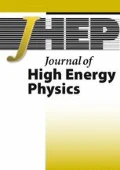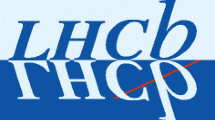Abstract
The first untagged decay-time-integrated amplitude analysis of B 0 s → K 0S K±π∓ decays is performed using a sample corresponding to 3.0 fb−1 of pp collision data recorded with the LHCb detector during 2011 and 2012. The data are described with an amplitude model that contains contributions from the intermediate resonances K*(892)0,+, K *2 (1430)0,+ and K *0 (1430)0,+, and their charge conjugates. Measurements of the branching fractions of the decay modes B 0 s → K*(892)±K∓ and \( {B}_s^0\to \overset{\left(\hbox{---} \right)}{K^{*}}{(892)}^0\overset{\left(\hbox{---} \right)}{K^0} \) are in agreement with, and more precise than, previous results. The decays B 0 s → K *0 (1430)±K∓ and \( {B}_s^0\to \overset{\left(\hbox{---} \right)}{K_0^{*}}{(1430)}^0\overset{\left(\hbox{---} \right)}{K^0} \) are observed for the first time, each with significance over 10 standard deviations.

Article PDF
Similar content being viewed by others
References
N. Cabibbo, Unitary symmetry and leptonic decays, Phys. Rev. Lett. 10 (1963) 531 [INSPIRE].
M. Kobayashi and T. Maskawa, CP violation in the renormalizable theory of weak interaction, Prog. Theor. Phys. 49 (1973) 652 [INSPIRE].
Y. Grossman and M.P. Worah, CP asymmetries in B decays with new physics in decay amplitudes, Phys. Lett. B 395 (1997) 241 [hep-ph/9612269] [INSPIRE].
R. Fleischer, CP violation and the role of electroweak penguins in nonleptonic B decays, Int. J. Mod. Phys. A 12 (1997) 2459 [hep-ph/9612446] [INSPIRE].
D. London and A. Soni, Measuring the CP angle β in hadronic b → s penguin decays, Phys. Lett. B 407 (1997) 61 [hep-ph/9704277] [INSPIRE].
M. Ciuchini et al., CP violating B decays in the standard model and supersymmetry, Phys. Rev. Lett. 79 (1997) 978 [hep-ph/9704274] [INSPIRE].
Belle collaboration, Time-dependent Dalitz plot measurement of CP parameters in B 0 → K 0 s π + π − decays, Phys. Rev. D 79 (2009) 072004 [arXiv:0811.3665] [INSPIRE].
BaBar collaboration, Time-dependent amplitude analysis of B 0 → K 0 S π + π −, Phys. Rev. D 80 (2009) 112001 [arXiv:0905.3615] [INSPIRE].
Belle collaboration, Measurement of CP-violating asymmetries in B 0 → K + K − K 0 S decays with a time-dependent Dalitz approach, Phys. Rev. D 82 (2010) 073011 [arXiv:1007.3848] [INSPIRE].
BaBar collaboration, Study of CP-violation in Dalitz-plot analyses of B 0 → K + K − K 0 S , B + → K + K − K + and B + → K 0 S K 0 S K +, Phys. Rev. D 85 (2012) 112010 [arXiv:1201.5897] [INSPIRE].
LHCb collaboration, Measurement of CP asymmetries in two-body B 0( s) -meson decays to charged pions and kaons, Phys. Rev. D 98 (2018) 032004 [arXiv:1805.06759] [INSPIRE].
LHCb collaboration, Measurement of CP-violation in B 0 s → ϕϕ decays, Phys. Rev. D 90 (2014) 052011 [arXiv:1407.2222] [INSPIRE].
LHCb collaboration, Measurement of CP-violation in the B 0 s → ϕϕ decay and search for the B 0 → ϕϕ decay, LHCb-CONF-2018-001 (2018).
LHCb collaboration, First measurement of the CP-violating phase \( {\phi}_s^{d\overline{d}} \) in B 0 s → (K + π −)(K − π +) decays, JHEP 03 (2018) 140 [arXiv:1712.08683] [INSPIRE].
LHCb collaboration, Study of B 0( s) → K 0 S h + h ′ − decays with first observation of B 0 s → K 0 S K ± π ∓ and B 0 s → K 0 S π + π −, JHEP 10 (2013) 143 [arXiv:1307.7648] [INSPIRE].
LHCb collaboration, Updated branching fraction measurements of B 0( s) → K 0 S h + h ′ − decays, JHEP 11 (2017) 027 [arXiv:1707.01665] [INSPIRE].
LHCb collaboration, Observation of B 0 s → K ∗ ± K ∓ and evidence for B 0 s → K ∗ − π + decays, New J. Phys. 16 (2014) 123001 [arXiv:1407.7704] [INSPIRE].
LHCb collaboration, First observation of the decay B 0 s → K 0 S K ∗(892)0 at LHCb, JHEP 01 (2016) 012 [arXiv:1506.08634] [INSPIRE].
M. Gronau, D. Pirjol, A. Soni and J. Zupan, Improved method for CKM constraints in charmless three-body B and B s decays, Phys. Rev. D 75 (2007) 014002 [hep-ph/0608243] [INSPIRE].
K. De Bruyn et al., Branching ratio measurements of B s decays, Phys. Rev. D 86 (2012) 014027 [arXiv:1204.1735] [INSPIRE].
LHCb collaboration, Measurement of resonant and CP components in \( {\overline{B}}_s^0\to J/\psi {\pi}^{+}{\pi}^{-} \) decays, Phys. Rev. D 89 (2014) 092006 [arXiv:1402.6248] [INSPIRE].
F. Dettori and D. Guadagnoli, On the model dependence of measured B s -meson branching fractions, Phys. Lett. B 784 (2018) 96 [arXiv:1804.03591] [INSPIRE].
H.-Y. Cheng and C.-K. Chua, Charmless three-body decays of B s mesons, Phys. Rev. D 89 (2014) 074025 [arXiv:1401.5514] [INSPIRE].
Y. Li, Branching Fractions and Direct CP Asymmetries of \( {\overline{B}}_s^0\to {K}^0{h}^{+}{h}^{\prime -}\left({h}^{\left(\prime \right)}=K,\pi \right) \) Decays, Sci. China Phys. Mech. Astron. 58 (2015) 031001 [arXiv:1401.5948] [INSPIRE].
Y. Li, W.-F. Wang, A.-J. Ma and Z.-J. Xiao, Quasi-two-body decays B (s) → K *(892)h → Kπh in perturbative QCD approach, Eur. Phys. J. C 79 (2019) 37 [arXiv:1809.09816] [INSPIRE].
LHCb collaboration, The LHCb detector at the LHC, 2008 JINST 3 S08005 [INSPIRE].
LHCb collaboration, LHCb detector performance, Int. J. Mod. Phys. A 30 (2015) 1530022 [arXiv:1412.6352] [INSPIRE].
R. Aaij et al., The LHCb trigger and its performance in 2011, 2013 JINST 8 P04022 [arXiv:1211.3055] [INSPIRE].
V.V. Gligorov and M. Williams, Efficient, reliable and fast high-level triggering using a bonsai boosted decision tree, 2013 JINST 8 P02013 [arXiv:1210.6861] [INSPIRE].
T. Sjöstrand, S. Mrenna and P.Z. Skands, A brief introduction to PYTHIA 8.1, Comput. Phys. Commun. 178 (2008) 852 [arXiv:0710.3820] [INSPIRE].
T. Sjöstrand, S. Mrenna and P.Z. Skands, PYTHIA 6.4 physics and manual, JHEP 05 (2006) 026 [hep-ph/0603175] [INSPIRE].
I. Belyaev et al., Handling of the generation of primary events in Gauss, the LHCb simulation framework, J. Phys. Conf. Ser. 331 (2011) 032047 [INSPIRE].
D.J. Lange, The EvtGen particle decay simulation package, Nucl. Instrum. Meth. A 462 (2001) 152 [INSPIRE].
P. Golonka and Z. Was, PHOTOS Monte Carlo: a precision tool for QED corrections in Z and W decays, Eur. Phys. J. C 45 (2006) 97 [hep-ph/0506026] [INSPIRE].
Geant4 collaboration, GEANT4 developments and applications, IEEE Trans. Nucl. Sci. 53 (2006) 270
Geant4 collaboration, GEANT4: a simulation toolkit, Nucl. Instrum. Meth. A 506 (2003) 250 [INSPIRE].
M. Clemencic et al., The LHCb simulation application, Gauss: design, evolution and experience, J. Phys. Conf. Ser. 331 (2011) 032023 [INSPIRE].
L. Breiman, J.H. Friedman, R.A. Olshen and C.J. Stone, Classification and regression trees, Wadsworth international group, Belmont, California U.S.A. (1984).
Y. Freund and R.E. Schapire, A decision-theoretic generalization of on-line learning and an application to boosting, J. Comput. Syst. Sci. 55 (1997) 119.
T. Skwarnicki, A study of the radiative cascade transitions between the ϒ′ and ϒ resonances, Ph.D. thesis, Institute of Nuclear Physics, Krakow, Poland (1986) [DESY-F31-86-02].
R.H. Dalitz,On the analysis of τ-meson data and the nature of the τ-meson, Phil. Mag. 44 (1953) 1068.
W.D. Hulsbergen, Decay chain fitting with a Kalman filter, Nucl. Instrum. Meth. A 552 (2005) 566 [physics/0503191] [INSPIRE].
Particle Data Group collaboration, Review of particle physics, Phys. Rev. D 98 (2018) 030001 [INSPIRE].
J. Back et al., LAURA ++ : a Dalitz plot fitter, Comput. Phys. Commun. 231 (2018) 198 [arXiv:1711.09854] [INSPIRE].
E. Ben-Haim, R. Brun, B. Echenard and T.E. Latham, JFIT: a framework to obtain combined experimental results through joint fits, arXiv:1409.5080 [INSPIRE].
G.N. Fleming, Recoupling effects in the isobar model. 1. General formalism for three-pion scattering, Phys. Rev. 135 (1964) B551 [INSPIRE].
D. Morgan, Phenomenological analysis of I = 12 single-pion production processes in the energy range 500 to 700 MeV, Phys. Rev. 166 (1968) 1731 [INSPIRE].
D. Herndon, P. Soding and R.J. Cashmore, A generalized isobar model formalism, Phys. Rev. D 11 (1975) 3165 [INSPIRE].
C. Zemach, Three pion decays of unstable particles, Phys. Rev. 133 (1964) B1201 [INSPIRE].
C. Zemach, Use of angular momentum tensors, Phys. Rev. 140 (1965) B97 [INSPIRE].
M. De Cian et al., Measurement of the track finding efficiency, LHCb-PUB-2011-025 (2011).
A. Martín Sanchez, P. Robbe and M.H. Schune, Performances of the LHCb L0 calorimeter trigger, LHCb-PUB-2011-026 (2011).
M. Adinolfi et al., Performance of the LHCb RICH detector at the LHC, Eur. Phys. J. C 73 (2013) 2431 [arXiv:1211.6759] [INSPIRE].
L. Anderlini et al., The PIDCalib package, LHCb-PUB-2016-021 (2016).
D. Aston et al., A study of K − π + scattering in the reaction K − p → K − π + n at 11 GeV/c, Nucl. Phys. B 296 (1988) 493 [INSPIRE].
W. Dunwoodie, Fits to \( K\pi I=\frac{1}{2} \) S-wave amplitude and phase data, available from http://www.slac.stanford.edu/~wmd/kpi_swave/kpi_swave_fit.note.
M. Williams, How good are your fits? Unbinned multivariate goodness-of-fit tests in high energy physics, 2010 JINST 5 P09004 [arXiv:1006.3019] [INSPIRE].
A. Rogozhnikov, Reweighting with boosted decision trees, J. Phys. Conf. Ser. 762 (2016) 012036 [arXiv:1608.05806] [INSPIRE].
LHCb collaboration, Measurement of the D + s − D − s production asymmetry in 7 TeV pp collisions, Phys. Lett. B 713 (2012) 186 [arXiv:1205.0897] [INSPIRE].
B. El-Bennich et al., CP violation and kaon-pion interactions in B → Kπ + π − decays, Phys. Rev. D 79 (2009) 094005 [Erratum ibid. D 83 (2011) 039903] [arXiv:0902.3645] [INSPIRE].
LHCb collaboration, Framework TDR for the LHCb Upgrade : Technical Design Report, CERN-LHCC-2012-007 (2012).
LHCb collaboration, Expression of interest for a Phase-II LHCb upgrade: opportunities in flavour physics and beyond, in the HL-LHC era, CERN-LHCC-2017-003 (2017).
Open Access
This article is distributed under the terms of the Creative Commons Attribution License (CC-BY 4.0), which permits any use, distribution and reproduction in any medium, provided the original author(s) and source are credited.
Author information
Authors and Affiliations
Consortia
Corresponding author
Additional information
ArXiv ePrint: 1902.07955
Deceased (R. Dzhelyadin, Y. Shcheglov)
A. Hicheur, C. Göbel and V. Salustino Guimaraes are associated to Universidade Federal do Rio de Janeiro (UFRJ), Rio de Janeiro, Brazil
G. Liu, H. Cai, L. Sun, B. Dey, W. Hu, M. Mukherjee, Y. Wang, D. Xiao, Y. Xie, M. Xu, H. Yin, J. Yu and D. Zhang are associated to Center for High Energy Physics, Tsinghua University, Beijing, China
D. A. Milanes, I. A. Monroy and J. A. Rodriguez Lopez are associated to LPNHE, Sorbonne Université, Paris Diderot Sorbonne Paris Cité, CNRS/IN2P3, Paris, France
O. Grünberg, M. Heß, N. Meinert, H. Viemann and R. Waldi are associated to Physikalisches Institut, Ruprecht-Karls-Universität Heidelberg, Heidelberg, Germany
C. J. G. Onderwater is associated to Nikhef National Institute for Subatomic Physics, Amsterdam, Netherlands
T. Likhomanenko, A. Malinin, O. Morgunova, A. Nogay, A. Petrov, V. Shevchenko, F. Baryshnikov, S. Didenko, A. Golutvin, N. Polukhina, E. Shmanin, G. Panshin and S. Strokov, A. Vagner are associated to Institute of Theoretical and Experimental Physics (ITEP), Moscow, Russia
D. Derkach, M. Hushchyn, N. Kazeev, F. Ratnikov and A. Ustyuzhanin are associated to Yandex School of Data Analysis, Moscow, Russia
L. M. Garcia Martin, L. Henry, B. K. Jashal, F. Martinez Vidal, A. Oyanguren, C. Remon Alepuz, J. Ruiz Vidal and C. Sanchez Mayordomo are associated to ICCUB, Universitat de Barcelona, Barcelona, Spain
C. A. Aidala, W. Dean, J. D. Roth, C. L. Da Silva and J. M. Durham are associated to Syracuse University, Syracuse, NY, United States
Rights and permissions
Open Access This article is licensed under a Creative Commons Attribution 4.0 International License, which permits use, sharing, adaptation, distribution and reproduction in any medium or format, as long as you give appropriate credit to the original author(s) and the source, provide a link to the Creative Commons licence, and indicate if changes were made.
The images or other third party material in this article are included in the article’s Creative Commons licence, unless indicated otherwise in a credit line to the material. If material is not included in the article’s Creative Commons licence and your intended use is not permitted by statutory regulation or exceeds the permitted use, you will need to obtain permission directly from the copyright holder.
To view a copy of this licence, visit https://creativecommons.org/licenses/by/4.0/.
About this article
Cite this article
The LHCb collaboration., Aaij, R., Abellán Beteta, C. et al. Amplitude analysis of B 0 s → K 0 S K±π∓ decays. J. High Energ. Phys. 2019, 114 (2019). https://doi.org/10.1007/JHEP06(2019)114
Received:
Revised:
Accepted:
Published:
DOI: https://doi.org/10.1007/JHEP06(2019)114




